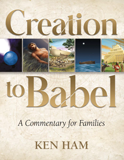
How the Bible Links the Accounts of Noah, Moses, and Jesus
Noah, Moses, and the Arks of Salvation
A close reading of the Torah shows a connection between Noah and Moses. This connection also points to the promised Redeemer through whom God would accomplish his purposes: the Lord Jesus.
A close reading of the Torah shows a connection between Noah and Moses.
The Torah was written by Moses in such a way that the reader can understand that earlier events prefigure and anticipate later events.1 These later events are also meant to remind the reader of past events.2 This is known as narrative typology or literary analogy.3 Literary analogy can be seen from shared words and thematic parallels in different texts. An example of this kind of analogy is the ark in which both Noah and Moses are saved from destructive waters. The Hebrew word tēbâ “ark”4 is only used in the Old Testament in the flood narrative (Genesis 6–9) and the account of Moses as a baby (Exodus 2:3, 5). This strongly suggests that there is a connection between the two accounts, as does the description of God’s rescue of Noah and his deliverance of Israel through Moses at the exodus. Just as God remembered Noah (Genesis 8:1) and sent a wind to blow over the earth so that all those in the ark could come out on dry ground (Genesis 8:13–14), so God also “remembered his covenant” he made with the patriarchs (Exodus 2:24) and sent “a strong east wind all night and made the sea dry land...” (Exodus 14:21) so that “the people of Israel went into the midst of the sea on dry ground...” (Exodus 14:22). These parallels are not a coincidence put together by multiple authors (documentary hypothesis) but are the work of a single author, Moses (Exodus 17:14, 34:27; cf. Mark 12:26).
Noah’s Ark
In Genesis 6, the earth had become corrupt and was filled with violence (Genesis 6:11), and so God warns Noah that he is going to destroy the earth and therefore commands him to build an ark (Genesis 6:13–14). The ark was to be made from gopher wood5 and covered inside and out with pitch (Genesis 6:14). God instructed Noah how to make the ark—length: 300 cubits (510 feet), width: 50 cubits (85 feet), height: 30 cubits (51 feet) (Genesis 6:15). The need of such a huge ark was to save Noah and his family and two (and seven6 of some) of every “kind” (mîn) of air-breathing, land-dwelling creatures from perishing in the global catastrophe (Genesis 6:18–20, 7:2–3; 2 Peter 2:5). God saved Noah and his household (Hebrews 11:7) and two of every kind of animal from a watery death (global flood) by shutting them in the ark (Genesis 7:16). Once they were safe from the destructive waters, they would start a new stage of God’s unfolding plan of redemption (Genesis 8:16–9:17). God used Noah in his redemptive purposes to bring about “relief/rest” from the curse (Genesis 5:29, 8:20–21).7
Moses’ Ark
When the Israelites were in Egypt, they “were fruitful and increased greatly; they multiplied and grew exceedingly strong, so that the land was filled with them” (Exodus 1:7; cf. Genesis 1:28). This caused the Pharaoh to instigate plans to afflict Israel because they were “too many and too mighty” (Exodus 1:9) for the Egyptians. The Pharaoh made three attempts to counter the increase of the Israelites: (1) he put taskmasters over them to afflict them with heavy burdens (Exodus 1:11); (2) he commanded the Hebrew midwives to kill the sons born to any Hebrew women (Exodus 1:15–21); and (3) he commanded that every son born to the Hebrews should be cast into the Nile (Exodus 1:22). After Pharaoh’s third plan, the narrative goes on to introduce the birth of God’s chosen deliverer, Moses (Exodus 2:1–2).
When Moses was around three months old, because of Pharaoh’s decree that all newborn sons should be thrown into the Nile (Exodus 1:22), his mother (Jochebed) placed him in an ark8 (tēbâ),9 which is covered with tarry bitumen, to preserve his life from the wicked Pharaoh (Exodus 2:3).10 The ark in which Moses is placed is hidden among the reeds of the Nile and found by the daughter of Pharaoh (Exodus 2:5–6). An Israelite audience would surely recall the ark that Noah and his family were saved in from the destructive waters. Just as Moses went into the Nile and was delivered from Pharaoh’s decree, so God took his people, Israel, through the waters of the Red Sea and rescued them from the Egyptians (Exodus 14). After their journey to Sinai, they later made their way to the promised land (Deuteronomy–Joshua). The arrangement of these accounts within the Torah is not an accident. It shows Moses is drawing a theme centered on God’s means of salvation.
Noah, Moses, and Jesus
The New Testament picks up on the redemptive accounts of Noah and Moses. The Apostle Peter tells us that the flood of Noah’s day is a type (historical fulfillment) of the salvation that comes to us in Jesus Christ. In 1 Peter 3:20, Peter states, “When God’s patience waited in the days of Noah, while the ark was being prepared, in which a few, that is, eight persons, were brought safely through water.” Peter makes the point that Noah and his family (eight people) were saved from the destructive waters of the flood in the ark (Genesis 7:6–7, 13). The water that destroyed the world in Noah’s day and through which Noah is saved “corresponds” (antitypon) to baptism for Christian believers (1 Peter 3:21; cf. Romans 6:4). Noah and his family’s salvation in the ark points to the salvation that has come in Jesus. Jesus is the “ark” of salvation, the one in whom we must trust to be saved from the judgment of God (John 10:9). The destruction of the earth through a global flood was a type of the final judgment that will come by fire on the last day when God judges the world but at the same time rescues the godly because they have been saved through Jesus Christ (2 Peter 2:9, 3:7).
In Matthew’s Gospel there is a clear parallel between the Pharaoh’s effort to slaughter the Hebrew boys (Exodus 1:22) and King Herod’s effort to kill all the male children in Bethlehem who were two years old or under (Matthew 2:16).
In Matthew’s Gospel there is a clear parallel between the Pharaoh’s effort to slaughter the Hebrew boys (Exodus 1:22) and King Herod’s effort to kill all the male children in Bethlehem who were two years old or under (Matthew 2:16). Pharaoh and Herod both killed the baby boys, but God divinely protected both Moses and Jesus, and just as the Hebrew midwives rebelled against Pharaoh (Exodus 1:17), so the magi rebelled against Herod’s order to tell him where the promised King was to be born (Matthew 2:7–12). Both Moses and Jesus fled to foreign lands to escape, and both waited in exile until God spoke to them to return to their lands (Exodus 2:15, 4:19; Matthew 2:13–15, 19–21). Moses and Jesus were both born at times of great peril to God’s people, but God used them to become deliverers of his people. But there is an important difference. Moses was a human child whom God used to rescue the nation of Israel from slavery (Exodus 13:3); whereas Jesus, the Prophet like Moses (Deuteronomy 18:1811), is the eternal Son of God (Galatians 4:4), who came from heaven to earth to rescue people from every tribe, language, people, and nation from their slavery to sin (Revelation 5:9).
Footnotes
- In Genesis, Joseph is a prefiguration of Moses. Both began as shepherds of flocks but would also shepherd people (Genesis 37:2; Exodus 3:1), both are separated from their families at an early age (Genesis 37:12–28; Exodus 2:1–10), both are Hebrew slaves in Egypt who become leaders in nations (Genesis 41:39–41; Exodus 2:10; Acts 7:22), both marry daughters of priests from the nations (Genesis 41:45; Exodus 2:16–21), both leave Egypt together (Genesis 50:25; Exodus 13:19), and both are rejected by the people whom God called them to save (Genesis 37:27–28, 50:20; Exodus 2:14, 14:30–31).
- In Genesis 9, Noah is a new “Adam” as he is given a renewed creation mandate (Genesis 9:1; cf. 1:28), he plants a vineyard (Genesis 9:20; cf. 2:8), he takes of the fruit of the vine (Genesis 9:21; cf. 3:6), he uncovers himself (Genesis 9:21; cf. 3:7), and his nakedness is covered up (Genesis 9:23; cf. 3:21).
- John Sailhamer, The Pentateuch As Narrative: A Biblical-Theological Commentary (Grand Rapids, Michigan: Zondervan, 1992), 37.
- In Exodus 2:3, 5, the ESV translates tēbâ as “basket,” but this is unwarranted as every other time tēbâ is found in the Torah it means ark (Genesis 6:14–16, 18–19, 7:1, 7, 9, 13, 15, 17–18, 23, 8:1, 4, 6, 9–10, 13, 16, 19, 9:10, 18). Elsewhere in the book of Exodus, the ESV translates the word “basket” from the Hebrew word sal (Exodus 29:3, 23, 32). The Hebrew word for “ark” in the “ark of the covenant” is אָרוֹן (ʾārôn).
- At present we are unable to identify what kind of wood gopher wood is. See Dr. Tim Chaffey, “Gopher Wood: The Mystery of the Ark’s Timber,” Answers in Genesis, October 7, 2020, https://answersingenesis.org/noahs-ark/gopher-wood-mystery-arks-timber/.
- Some scholars suggest seven pairs.
- In Hebrew, Noah’s name is נֹחַ (nōaḥ) and is related to the word for “rest.” In Genesis 5:29, we read that Lamech “called his name Noah, saying, ‘Out of the ground that the Lord has cursed, this one shall bring us relief from our work and from the painful toil of our hands.’” The word for “relief” (nāḥam) shares two of the same Hebrew consonants (נח) with the word “rest” and picks up the sounds in the name “Noah,” forming a wordplay on the name. Because of the wickedness of mankind, God “regrets” (nāḥam) that he made man, but Noah finds “grace” (ḥēn—in Hebrew, nōaḥ spelled backward) in God’s eyes (Genesis 6:6–8). The ark Noah was saved in came to “rest” (nûaḥ) upon the mountains of Ararat (Genesis 8:4). The dove Noah sent out from the ark found no place to “set/rest” (mānôaḥ) her foot (Genesis 8:9). However, after he comes out of the ark, Noah builds an altar and offers burnt offerings to the Lord, the aroma of which is “pleasing” (nîḥōaḥ—from the same root as Noah’s name) to the Lord (Genesis 8:21). As a result of Noah’s offering, which shows how he brings relief from the curse (Genesis 5:29), God promises that he “will never again curse the ground because of man . . .” (Genesis 8:21). See Seth D. Postell, Eitan Bar, and Erez Soref, Reading Moses, Seeing Jesus: How the Torah Fulfills Its Goals in Yeshua (Bellingham, Washington: Lexham Press, 2017), 67–69.
- Some try to find a parallel between Moses’ deliverance in his ark and Sargon of Akkad (c. 2334 BC), in which Sargon survived at birth in a chest floating on the Euphrates. However, there are several problems with this: “Saying Israel used this to invent the account in Exodus would undermine its reliability. But there are other difficulties with the Sargon comparison, not the least of which is the fact that the meaning and function of the Sargon story are unclear. Second, there is no outside threat to the child Sargon. The account simply shows how a child was exposed, rescued, nurtured, and became king. Third, other details do not fit: Moses’ father is known, Sargon’s is not; Moses is never abandoned, since he is never out of the care of his parents, and the finder is a princess and not a goddess. Moreover, without knowing the precise function and meaning of the Sargon story, it is almost impossible to explain its use as a pattern for the biblical account. By itself, the idea of a mother putting a child by the river if she wants him to be found would have been fairly sensible, for that is where the women of the town would be washing their clothes or bathing. If someone wanted to be sure the infant was discovered by a sympathetic woman, there would be no better setting” (See note 10 in “Exodus 2,” NET Bible, https://netbible.org/bible/Exodus+2). The parallel of Moses’ ark is clearly the account of the ark in Genesis 6–8.
- The word tēbâ (box, chest) is most likely an Egyptian loan word, as it is related to the Egyptian word for “coffin” (Egyptians believed they were preserving the body for the afterlife). Egyptian loan words in the Hebrew text are understandable, given that Moses, the author of Exodus (Exodus 17:14, 34:27), was educated in Egypt (Acts 7:22).
- The words used in Exodus 2:3 for “tarry bitumen” (baḥēmār ûbazzāpet) are not the same as the word for “pitch” (kōper) in Genesis 6:14. However, this does not mean there is not an allusion between the narratives.
- See Simon Turpin, “Who Is the Prophet Like Moses?” Answers in Genesis, December 10, 2022, https://answersingenesis.org/jesus/who-is-prophet-like-moses/.
Recommended Resources

Answers in Genesis is an apologetics ministry, dedicated to helping Christians defend their faith and proclaim the good news of Jesus Christ.
- Customer Service 800.778.3390
- © 2025 Answers in Genesis






